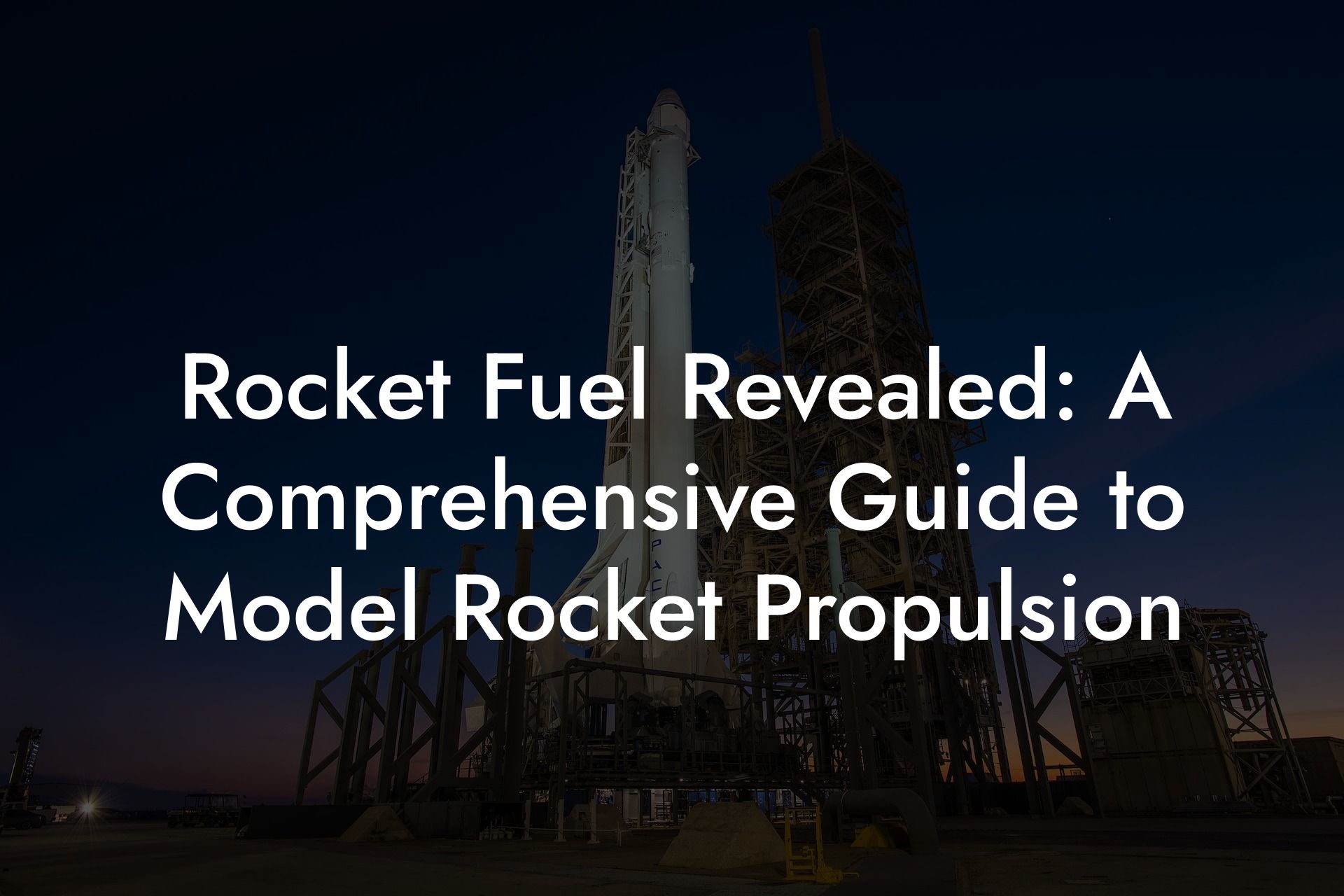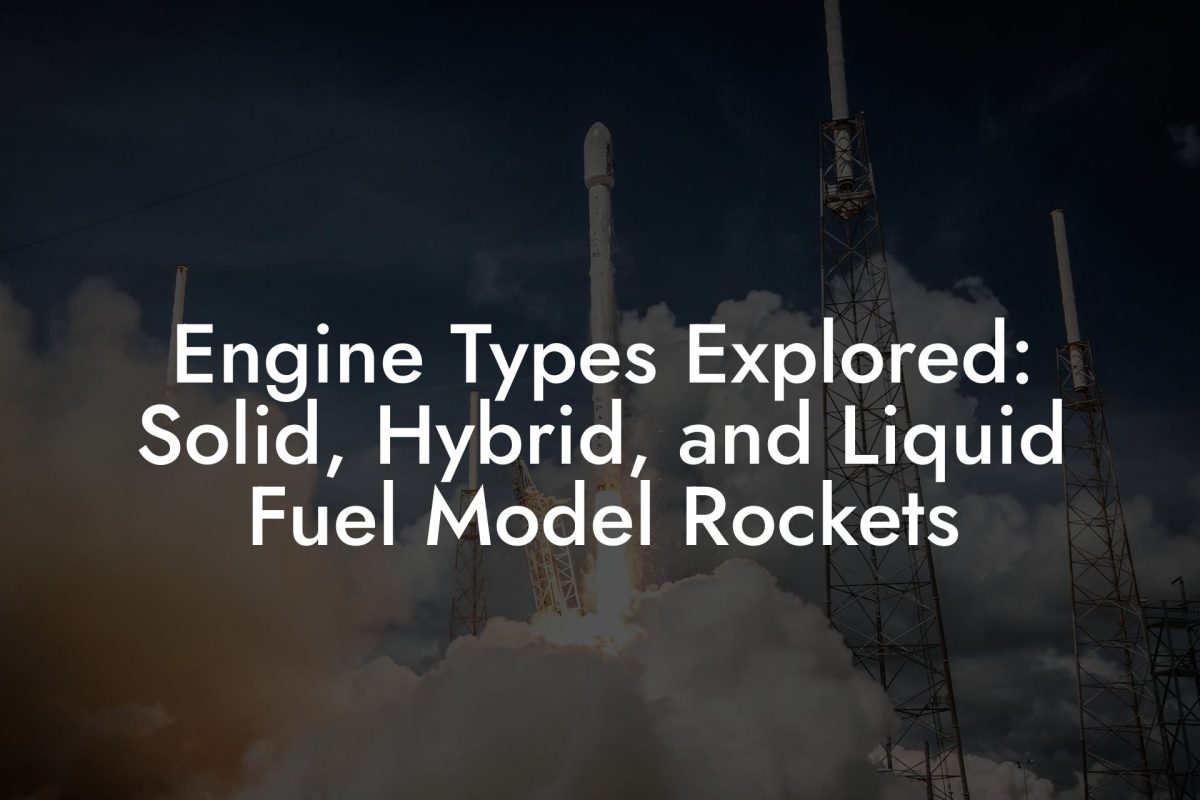Welcome to "Rocket Fuel Revealed: A Comprehensive Guide to Model Rocket Propulsion." If you've ever wondered what ignites the incredible power behind your model rocket's liftoff, you're in the right place. This guide dives deep into the chemistry, technology, and safety behind rocket fuel, uncovering the secrets that turn potential energy into a spectacular burst of thrust. Whether you're a beginner eager to learn or a seasoned rocketeer looking to optimize your engine’s performance, prepare to fuel your passion with knowledge that propels you to new heights.
Quick Links to Useful Sections
- The Basics of Rocket Fuel: What Makes a Rocket Go?
- Types of Model Rocket Fuel
- Solid Rocket Propellants
- Hybrid Rocket Propellants
- Liquid Rocket Propellants (Experimental)
- The Chemistry Behind Rocket Fuels
- Safety Considerations for Handling Rocket Fuel
- Storage, Maintenance, and Shelf Life of Rocket Fuel
- Innovations in Rocket Fuel: The Future of Model Propulsion
- Enhanced Solid Propellants
- Hybrid Propellant Advances
- Eco-Friendly Propellants
- Digital Control and Optimization
- Testing and Optimizing Engine Performance
- Model Rocket Fuel FAQs: Your Questions Answered
- Your Next Launch: Fuel Your Flight with Innovation and Precision
The Basics of Rocket Fuel: What Makes a Rocket Go?
At its core, rocket fuel is all about converting stored chemical energy into kinetic energy. In model rocketry, fuel formulations are designed to be compact, safe, and efficient. When ignited, the fuel burns rapidly, producing hot gases that expand and are expelled through the nozzle. This reaction creates the thrust needed to overcome gravity and launch your rocket skyward.
This process is governed by Newton’s third law of motion, every action has an equal and opposite reaction. The energy released during combustion pushes the rocket in the opposite direction, propelling it upward. Understanding this basic principle lays the groundwork for exploring the diverse types of rocket fuels available and their specific properties.
Types of Model Rocket Fuel
Model rocketry primarily utilizes a few key types of fuel, each with its own characteristics, advantages, and limitations. Let’s take a closer look at the most common fuel types used by rocketeers today:
Solid Rocket Propellants
Solid fuels are the most prevalent type in model rocketry. These fuels are typically pre-mixed and cast into a specific shape within the engine casing. The advantages of solid rocket propellants include their simplicity, reliability, and ease of storage.
Looking For The Best Model Rocket Kits? You'll Love These:
Pros:
- Simple design with no moving parts
- Reliable ignition and predictable burn characteristics
- Long shelf life under proper storage conditions
Cons:
- Once ignited, the burn cannot be controlled or throttled
- Limited ability to adjust thrust during flight
Hybrid Rocket Propellants
Hybrid fuels combine a solid fuel with a liquid oxidizer. This combination allows for more precise control over the burn rate and thrust, offering a compromise between the simplicity of solid fuels and the controllability of liquid fuels.
Pros:
- Adjustable thrust and burn characteristics
- Improved performance efficiency
Cons:
- More complex design and assembly
- Requires careful handling of liquid oxidizers
Liquid Rocket Propellants (Experimental)
Although less common in hobbyist model rocketry, liquid fuels offer the highest level of control. These systems use separate liquid fuel and oxidizer tanks and typically involve more advanced technology and safety protocols.
Pros:
- Highly controllable thrust and burn duration
- Potential for multi-phase burns and throttling during flight
Cons:
- Complex engineering and higher safety risks
- Requires specialized equipment and professional-grade components
The Chemistry Behind Rocket Fuels
Rocket fuels are a fascinating blend of chemistry and engineering. The fuel’s composition determines not only how much energy is released during combustion but also the speed and temperature of the exhaust gases. Common components in solid rocket fuels include:
- Oxidizers: Chemicals like ammonium perchlorate supply the oxygen needed for combustion.
- Fuels: Materials such as powdered aluminum or sugar derivatives provide the combustible substance.
- Binders: These act as both a fuel and a structural component, holding the mixture together (e.g., hydroxyl-terminated polybutadiene or HTPB).
- Stabilizers and Catalysts: Added to control the burn rate and ensure a steady combustion process.
Each ingredient plays a vital role in ensuring the fuel burns consistently and safely, delivering the thrust required to launch your rocket. The careful balance of these components is what makes modern rocket fuels both powerful and reliable.
Safety Considerations for Handling Rocket Fuel
Safety is paramount when dealing with rocket propellants. Whether you’re working with solid fuels or exploring experimental hybrid or liquid systems, adhering to strict safety protocols is essential.
- Storage: Keep fuels in a cool, dry, and well-ventilated area away from direct sunlight. Follow manufacturer guidelines for temperature and humidity levels.
- Handling: Always wear appropriate personal protective equipment (PPE), such as gloves and eye protection. Work in a designated area free from ignition sources.
- Mixing and Casting: If you’re involved in preparing your own fuel, ensure that you have the proper equipment, ventilation, and expertise. Follow all safety guidelines to avoid accidental ignition or toxic exposure.
- Disposal: Dispose of any unused or expired propellant in accordance with local regulations and safety guidelines.
By following these precautions, you can minimize the risks associated with rocket fuels and ensure that your model rocketry experience remains both exciting and safe.
Storage, Maintenance, and Shelf Life of Rocket Fuel
Proper storage and maintenance of rocket fuel are essential to preserving its performance over time. Solid rocket fuels, for instance, can have a long shelf life if kept in optimal conditions. Key tips include:
- Temperature Control: Store fuel in a temperature-controlled environment to prevent degradation or unintended reactions.
- Moisture Prevention: Use airtight containers and desiccants to avoid moisture absorption, which can compromise the fuel's stability.
- Regular Inspections: Periodically inspect fuel storage for signs of degradation, such as discoloration or unusual odors, and dispose of any compromised material safely.
Maintaining your rocket fuel properly ensures that your engines perform as expected, launch after launch.
Innovations in Rocket Fuel: The Future of Model Propulsion
The field of rocket propulsion is constantly evolving. New research and technological advancements are leading to the development of more efficient, powerful, and environmentally friendly propellants. Some exciting innovations include:
Enhanced Solid Propellants
Researchers are exploring new formulations that deliver higher thrust and longer burn times while maintaining safety. These enhanced solid propellants could enable model rockets to achieve greater altitudes and more stable flight profiles.
Hybrid Propellant Advances
Hybrid engines, which combine solid fuels with liquid oxidizers, are being refined to offer adjustable thrust and improved efficiency. This technology bridges the gap between traditional solid propellants and more complex liquid systems.
Eco-Friendly Propellants
In response to environmental concerns, there is a growing focus on developing rocket fuels that reduce toxic emissions. Eco-friendly propellants are designed to burn cleaner while still providing the robust performance required for model rocketry.
Digital Control and Optimization
Advances in microelectronics and digital control systems are beginning to make their way into model rocket engines. These systems allow for real-time monitoring and adjustments during flight, optimizing engine performance and enhancing safety.
These innovations not only push the boundaries of what’s possible in model rocketry but also open up exciting new avenues for experimentation and performance enhancement.
Testing and Optimizing Engine Performance
To get the most out of your rocket fuel, rigorous testing and optimization are key. Many rocketeers use simulation software and controlled test launches to measure engine performance. Key metrics to monitor include:
- Thrust: The force generated during fuel combustion.
- Burn Time: The duration over which the engine produces thrust.
- Impulse: The total momentum change, which is a function of thrust and burn time.
By collecting data from test launches, you can fine-tune fuel formulations, engine designs, and nozzle configurations to optimize performance. Iterative testing is a cornerstone of successful model rocketry, it transforms theoretical designs into high-flying reality.
Model Rocket Fuel FAQs: Your Questions Answered
Here are some frequently asked questions that cover common concerns about model rocket fuels, helping you navigate the complex world of propulsion.
1. What is the main function of rocket fuel?
Rocket fuel converts stored chemical energy into kinetic energy, producing thrust that propels the rocket upward by expelling exhaust gases at high speed.
2. What types of fuel are most common in model rocketry?
The most common fuels are solid rocket propellants, though hybrid and experimental liquid fuels are also used, especially by advanced enthusiasts.
3. How do solid rocket engines work?
Solid rocket engines burn a pre-mixed solid propellant contained within a casing. As the propellant combusts, it produces hot gases that are expelled through a nozzle, generating thrust.
4. What are the advantages of hybrid rocket engines?
Hybrid engines allow for adjustable burn rates and improved efficiency by combining the simplicity of a solid fuel with the controllability of a liquid oxidizer.
5. How should I store my rocket fuel?
Store rocket fuel in a cool, dry, and well-ventilated area. Use airtight containers to prevent moisture ingress and always follow the manufacturer’s guidelines.
6. Are there eco-friendly rocket fuels available?
Yes, ongoing research is developing eco-friendly propellants that reduce toxic emissions while still providing sufficient thrust for model rocketry.
7. What safety precautions should be taken when handling rocket fuel?
Always wear protective gear, follow proper storage guidelines, work in a designated area away from ignition sources, and adhere to manufacturer instructions during handling and mixing.
8. How can I optimize engine performance?
Optimize performance by selecting the right fuel for your design, conducting rigorous test launches, and using simulation tools to fine-tune parameters like thrust, burn time, and impulse.
9. What role does the nozzle play in propulsion?
The nozzle converts the thermal energy from burning fuel into directed thrust. Its shape and design are critical for maximizing engine efficiency.
10. What future innovations can we expect in rocket fuel technology?
Look forward to advancements in hybrid engine control, eco-friendly propellant formulations, enhanced solid fuel efficiency, and the integration of digital controls for real-time performance optimization.
Your Next Launch: Fuel Your Flight with Innovation and Precision
Rocket fuel is more than just a chemical mixture, it’s the lifeblood of your model rocket, powering your dreams and propelling you into the stratosphere. With a deeper understanding of fuel types, combustion chemistry, and the latest innovations in engine technology, you're now equipped to make informed choices that enhance performance and ensure safety.
As you continue your rocketry journey, remember that every test launch and every data point is an opportunity to refine your approach. Embrace the science, respect the safety protocols, and let your passion for propulsion guide you. The next time you ignite your engine, know that you’re not just launching a rocket, you’re launching a legacy of innovation and exploration.
The sky is the beginning, so fuel up, get ready, and propel your flight to new heights!
Looking For The Best Model Rocket Kits? You'll Love These:
Useful Interruption: Dive deeper into the world of Model Rockets with our most popular sections. If there is anything you think is missing or anything you would love for us to write about, just give us a shout.
- Getting Started & Basics With Model Rockets
- Model Rocket Design, Build & Customization
- Model Rocket Propulsion & Engine Technology
- Model Rocket Launch Techniques & Recovery
- Model Rocket Advanced Rocketry & Innovations
- Model Rocket DIY and Customization
- Model Rocket Equipment Reviews & Digital Tools
- Community, Competitions & Education
- Model Rocket Troubleshooting & FAQs
- Model Rocket Bonus/Seasonal & Niche Topics
A group of model rocket enthusiasts gathered at a field for their weekly launch event. Among them was Dave, a seasoned builder known for pushing the limits of hobby rocketry. This time, he had outdone himself.
“Ladies and gentlemen,” Dave announced, dramatically pulling a cloth off his latest creation, “I present to you: The Kraken!”
The crowd gasped. This wasn’t just a model rocket, it was a monster. The thing stood 8 feet tall, had six clustered engines, and was covered in enough duct tape to qualify as a classified aerospace project.
“Dave,” muttered Steve, the cautious safety officer, “Have you, uh… done the math on this?”
“Math?” Dave scoffed. “I built it in my garage at 3 a.m. with parts from eBay. This is an art piece, Steve.”
The countdown began.
5…
4…
3…
2…
1…
The engines ignited with a BOOM, and The Kraken shot up… kind of. It immediately did a violent barrel roll, narrowly missing the spectators before skyrocketing at an angle that could only be described as “legally questionable.”
The crowd collectively ducked as The Kraken flew straight over the adjacent cornfield, where Old Man Jenkins, the grumpiest farmer in town, was minding his business.
KABOOM!
The rocket disappeared behind the barn. A moment later, a flaming piece of Estes igniter wire landed at Steve’s feet. The silence was deafening.
And then, an unmistakable sound echoed across the field.
Jenkins’ shotgun being cocked.
“DAVE!!!” Steve shouted. “RUN.”
And that was the day Dave invented the first-ever biologically powered rocket booster: pure adrenaline.
To this day, nobody knows where The Kraken landed, but legend has it, it still haunts the skies, terrifying unsuspecting drones and low-flying birds.






